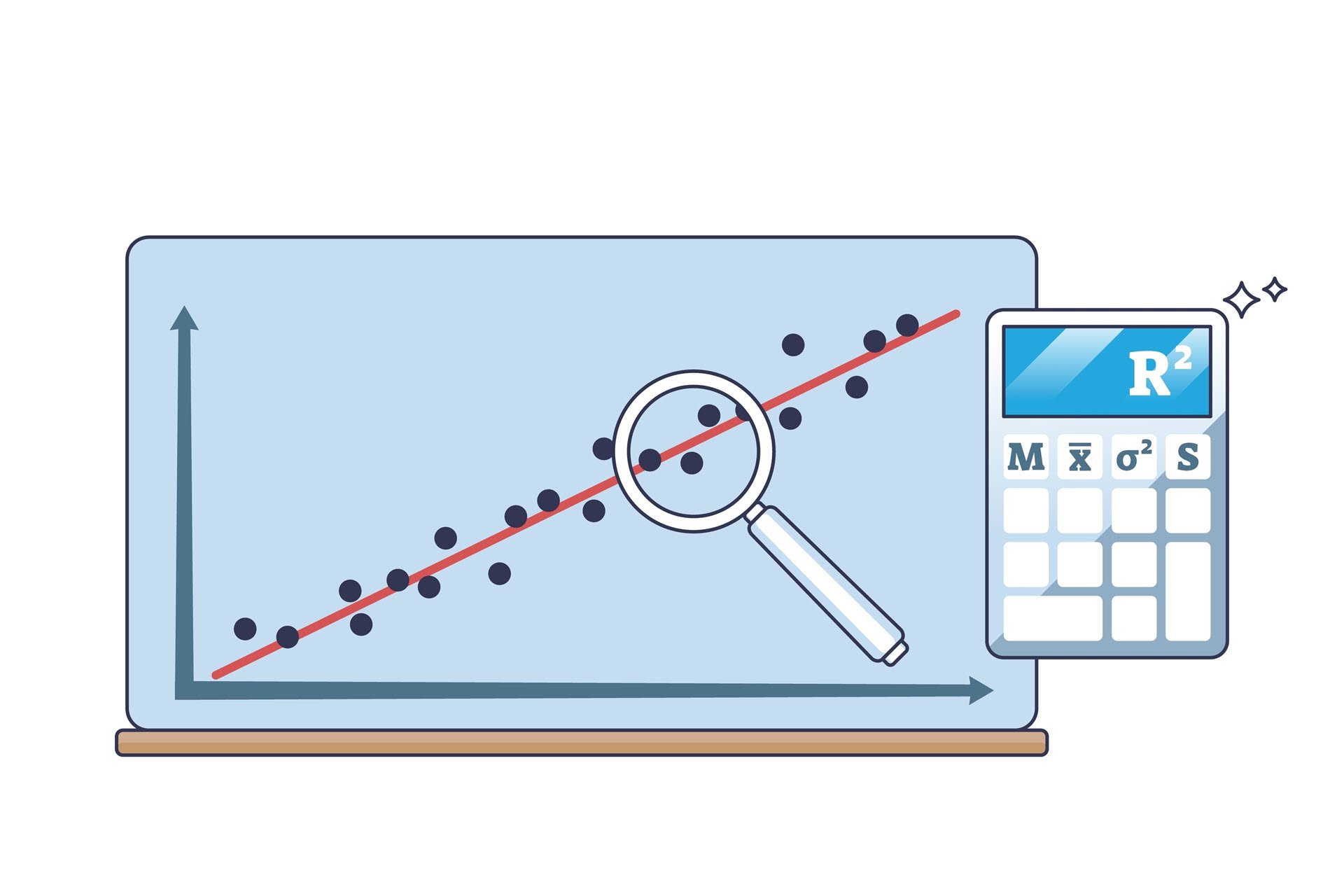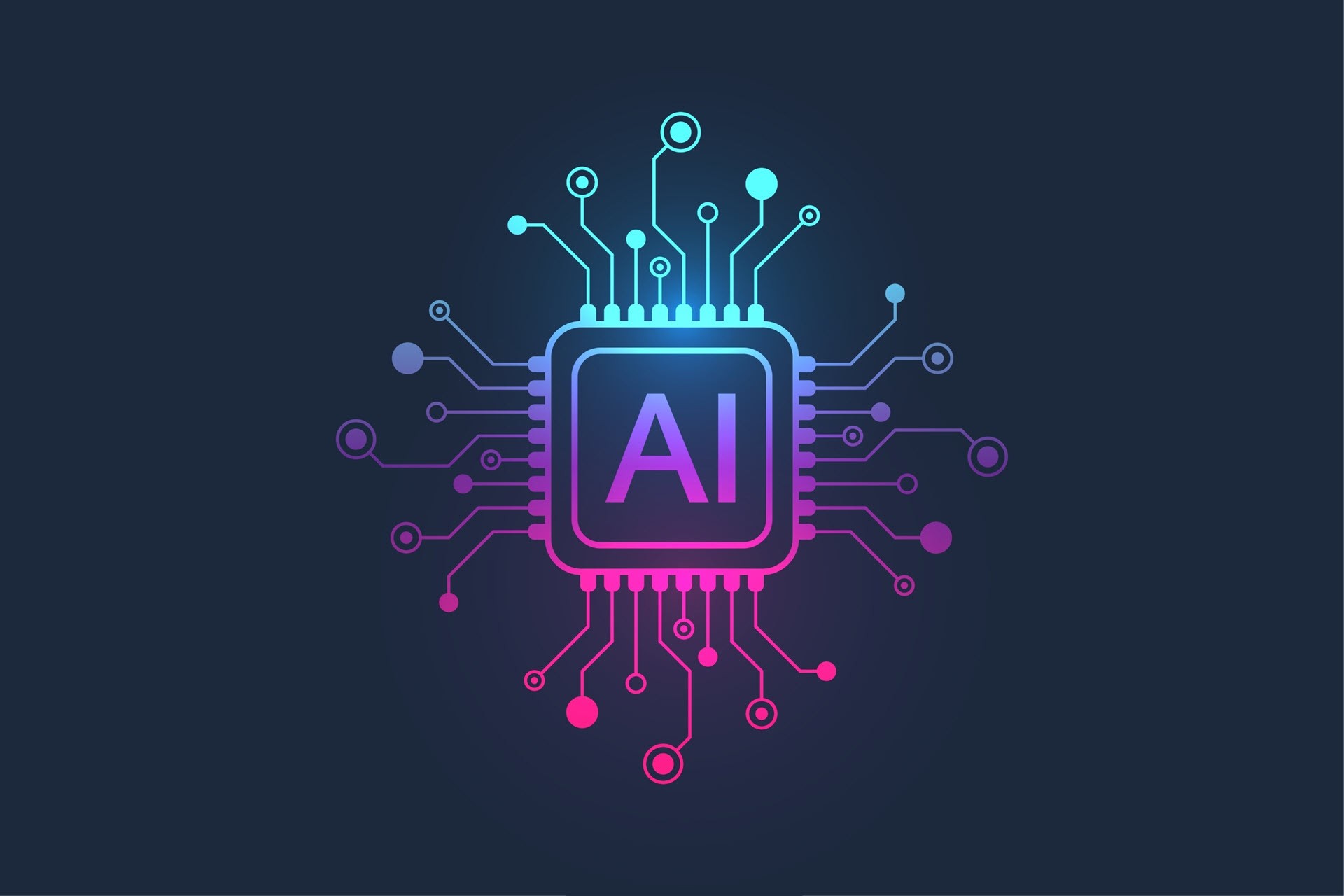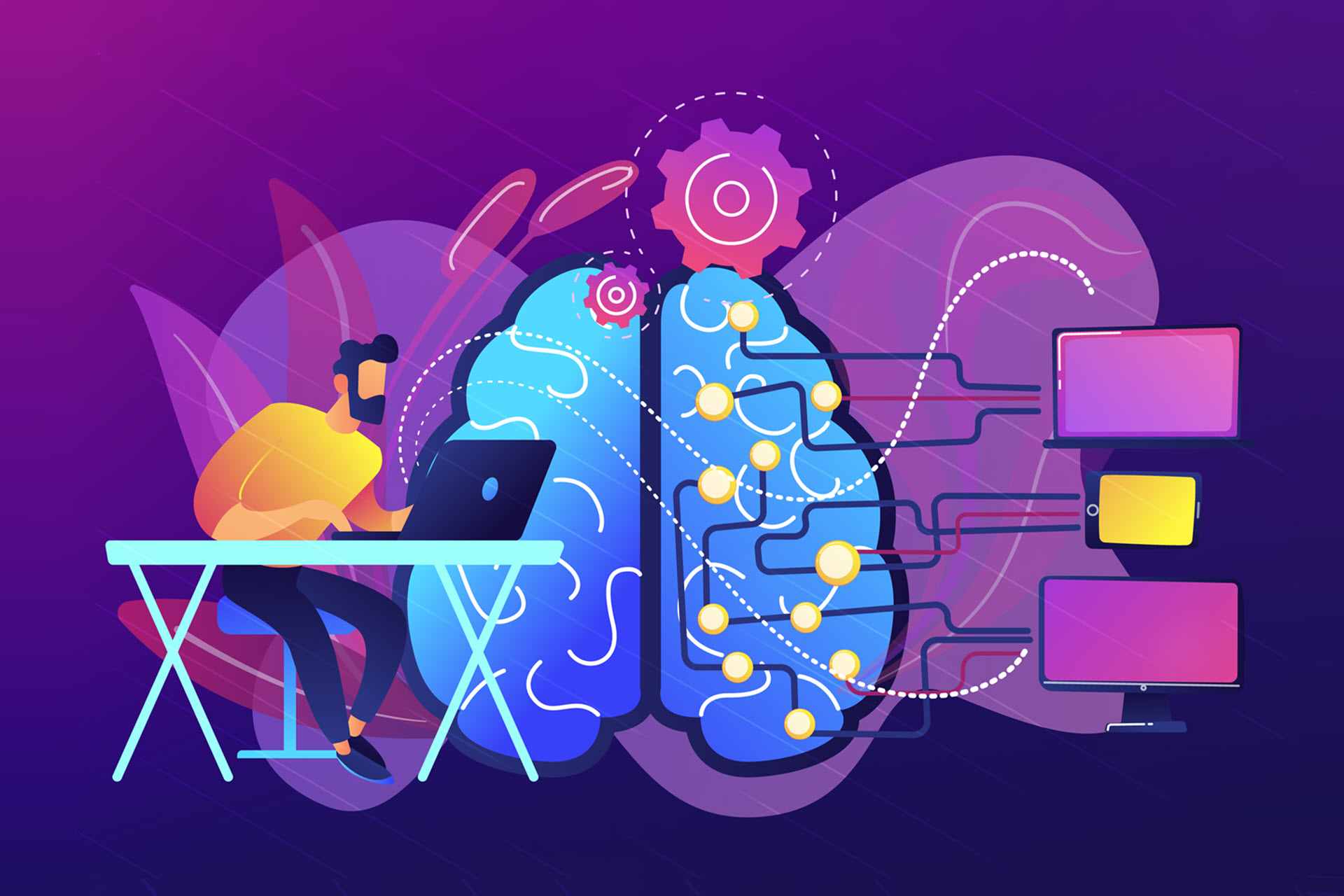Thinking about getting into artificial intelligence (AI) development? It's an excellent career move. By 2030, AI will contribute $15.7 trillion to the global economy, with AI specialist roles predicted to be the fastest-growing jobs in the world.
If you're interested in pursuing a career in AI, you'll have to learn how to code. You can write AI applications in a variety of programming languages, but only a handful of them are an excellent fit with AI programming.
This article provides an overview of the top 10 AI programming languages. Jump in to see which languages should be at the top of your learning list and find out what makes them an excellent choice for AI projects.
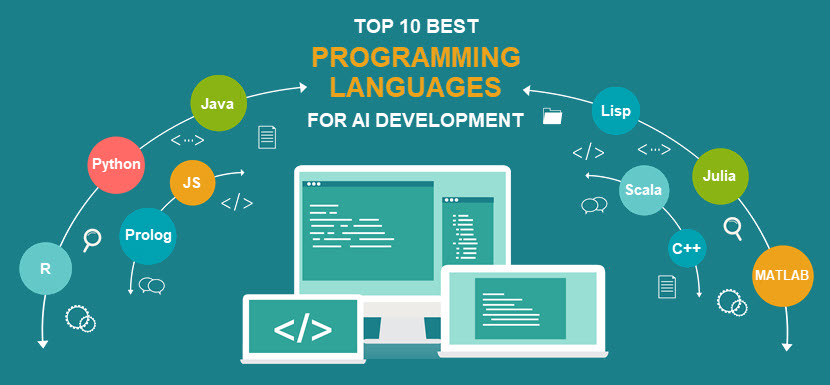
Top 10 Programming Languages for Artificial Intelligence
The table below provides a high-level comparison of the top AI programming languages:
| Programming Language | Strengths | Weaknesses | Good for AI Because | Go-To AI Fields |
|---|---|---|---|---|
| Python | Extensive libraries, a large community, easy to learn. | Slower execution speed than compiled languages, GIL limits multi-threading. | Rich ecosystem of AI/ML libraries, active community, and versatility. | Machine learning, deep learning, data science, NLP. |
| C++ | High performance, fine-grained control over system resources, mature and stable. | Complex syntax, manual memory management. | High efficiency and performance. | Real-time AI systems, game AI, computer vision. |
| Java | Platform-independent, high-performance, strong support for concurrency. | Verbose syntax, slower to develop compared to other languages. | Strong performance and scalability, mature ecosystem. | Large-scale ML, enterprise AI applications. |
| R | Strong statistical analysis, data visualization, various packages. | Slower than other languages, less general-purpose. | Statistical analysis and data manipulation. | Statistical analysis, data mining. |
| Julia | High performance for numerical computing, easy-to-read syntax. | Smaller community, not enough libraries. | High-performance numerical computing. | Numerical analysis, scientific simulations. |
| Lisp | Excellent for symbolic computation, dynamic typing. | Performance limitations, smaller ecosystem. | Symbolic reasoning capabilities. | Symbolic AI, NLP, expert systems. |
| Prolog | Strong in symbolic reasoning and logic programming, pattern matching, and backtracking. | Steep learning curve, smaller ecosystem. | Logical inference and symbolic reasoning capabilities. | Rule-based systems, knowledge representation, automated theorem proving. |
| Scala | A mix of functional and object-oriented programming, concurrency support. | Complexity, longer compilation times, smaller ecosystem. | Integrates well with big data frameworks. | Big data processing (Apache Spark-based AI applications), scalable ML. |
| MATLAB | Extensive mathematical and statistical tools. | High licensing cost, less flexible for general-purpose programming. | Strong toolboxes for AI, numerical analysis. | Data analysis, algorithm development, prototyping. |
| JavaScript | Wide adoption, cross-platform compatibility, rich web integration. | Performance limitations, fewer mature AI libraries. | Seamless integration with web technologies. | Web-based AI, interactive AI applications, real-time AI systems. |
Let's dive deeper into each AI programming language covered in this table.
Python
Python is a high-level, general-purpose programming language viewed by many as the de facto language for AI development due to its simplicity, extensive ecosystem, and supportive community.

It is a standard choice for machine learning (ML) systems, computer vision applications, natural language processing (NLP), and general AI prototyping. Here's exactly what makes Python the go-to programming language for AI projects:
- Various libraries and frameworks. Libraries like TensorFlow, PyTorch, Keras, Scikit-Learn, and Pandas provide powerful tools for ML, deep learning, and data analysis. These libraries accelerate AI development with ready-made components and code.
- Ease of use. Python's simple and clean syntax allows developers to write and debug code quickly.
- Strong community support. Python has a vast and active community. Aspiring developers have access to abundant resources, tutorials, and forums where they can seek help if they run into problems.
- Cross-platform compatibility. Python runs on various platforms, including Windows, macOS, and Linux. Developers can create and deploy applications across different operating systems without significant changes to the codebase.
Despite these advantages, Python does have some drawbacks when used in AI projects. The most notable issue is that Python is an interpreted language, so it is slower than compiled languages. Luckily, Python can easily integrate with other languages like C/C++ and Java. Many developers decide to write performance-critical components in these languages while keeping the high-level logic in Python.
Python's memory management can also be less efficient than that of other languages. This limitation is problematic for large-scale AI applications that require extensive memory usage.
Want to give Python a go? Learn how to install Python on Windows, Ubuntu, and Rocky Linux.
C++
C++ is a general-purpose programming language known for its speed, efficiency, and fine-grained control over system resources. This language is widely used in various domains, including game development, systems programming, and applications requiring real-time processing.

In AI, C++ is valuable for implementing algorithms that demand high computational power and deploying AI models into low-latency production environments.
Here's why C++ is worth learning if you are an aspiring AI developer:
- High performance levels. C++ is a compiled language, which allows it to be executed extremely fast. This high performance is essential for AI applications that involve heavy computational tasks, such as training deep neural networks or processing large data sets.
- Low-level memory management. C++ provides direct control over memory allocation and deallocation. Developers get to optimize memory usage, which is beneficial when you must manage large data sets or ensure efficient use of system resources.
- Fine-grained control over hardware. The ability to interact closely with hardware allows C++ developers to optimize AI algorithms for specific configurations. This feature is crucial for use cases that require real-time performance, such as robotics and embedded systems.
- Libraries and frameworks. C++ has a rich set of libraries and frameworks for AI development. Developers get to use TensorFlow (C++ API), Caffe, Dlib, and Shark to speed up projects involving ML, computer vision, and neural networks.
C++ excels at use cases with millisecond latency, such as high-frequency trading algorithms and autonomous robotics. However, this language does have some limitations.
C++ is a complex language with a more intricate syntax compared to higher-level languages (especially Python). Mastering C++ requires a deep understanding of its programming concepts, which can be challenging for beginners.
Additionally, low-level memory management increases the risk of memory leaks and segmentation faults. Manually managing memory requires careful attention and makes the development process more prone to errors.
Java
Java is a high-level, object-oriented programming language known for its "write once, run anywhere" (WORE) mantra. It is platform-independent at the source and binary levels thanks to the Java Virtual Machine (JVM).
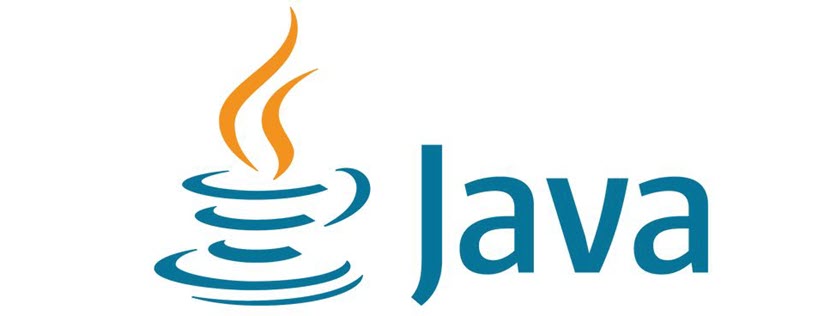
Its robustness, extensive standard library, and high performance make Java an excellent option for building large-scale enterprise applications involving AI.
Here are the main reasons why Java is so suitable for AI development:
- Platform independence. Java's platform-independent nature allows you to run AI applications on any device with a JVM. This cross-platform compatibility is advantageous when deploying AI solutions across different environments.
- Excellent performance. Java's efficient memory management and just-in-time (JIT) compilation contribute to faster execution.
- A rich ecosystem. Java offers a wide range of libraries and frameworks for AI and machine learning (e.g., Deeplearning4j, Weka, MOA, Apache Spark MLlib). These tools provide valuable assets for developing AI models and analyzing data.
- Multi-threading and concurrency. Java's built-in support for multi-threading and concurrency enables efficient execution of parallel processes. This feature is vital in AI applications that involve intensive computational tasks.
As for the drawbacks, writing and maintaining Java code is time-consuming, which often slows down the development process. Higher complexity also means Java has a considerably steep learning curve.
Additionally, while Java has various AI libraries, its ecosystem is not as mature or extensive as Python's. Most cutting-edge AI and machine learning frameworks, such as TensorFlow and PyTorch, are primarily developed and maintained for Python.
Our head-to-head comparison of PyTorch and TensorFlow offers an in-depth look at what sets these two frameworks apart.
R
R is a programming language primarily used for statistical computing. The language's features make it well-suited for data analysis and statistical modeling, which are foundational elements in AI development.

R's ability to handle and analyze large data sets enables developers to build sophisticated AI models. Here is why R earned its place among the most popular AI programming languages:
- Statistical analysis. R is designed primarily for statistical analysis. The language includes a wide range of built-in statistical tests, models, and tools, making it ideal for AI tasks that require robust statistical computation.
- An extensive package selection. R has a vast ecosystem of packages available through CRAN (Comprehensive R Archive Network). Developers get access to machine learning packages that offer ready-to-use AI algorithms.
- Data manipulation. R excels at data wrangling and manipulation, so developers can easily preprocess and clean data. These capabilities make it easier to transform and prepare data for AI models.
- Advanced visualization. R's graphical capabilities enable the creation of complex and informative data visualizations. This capability is crucial for understanding data patterns, model diagnostics, and results interpretation in AI projects.
On the negative side, R is slower than languages like Python, C++, or Java in terms of execution speed. This issue can be a limitation for large-scale AI applications that require high performance and efficiency.
While R is excellent for data analysis and statistical tasks, it is less useful for other types of development (e.g., web development, automation, general-purpose programming). This issue limits R's utility in projects that require diverse programming capabilities.
R also has a steep learning curve. Those new to programming or coming from other languages often find R's syntax and functional programming paradigm challenging to learn.
Julia
Julia is a high-level programming language that combines the ease of use of languages like Python with the performance of languages like C++. The language is particularly well-suited for tasks that involve heavy numerical computation.
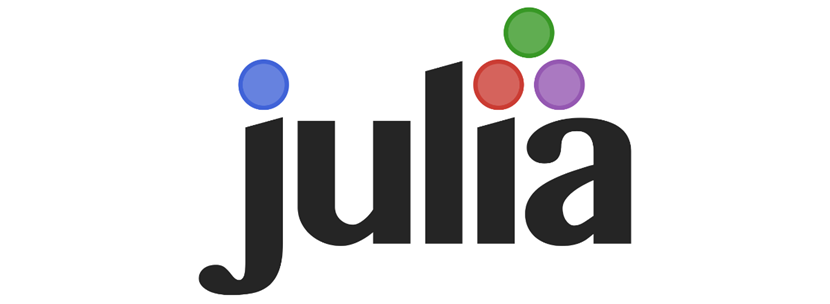
Here are the main reasons we decided to include Julia in this article:
- High performance. Julia is a compiled language that uses LLVM (Low-Level Virtual Machine) to generate efficient code. This feature results in performance comparable to C and Fortran, which is crucial for computationally intensive AI tasks.
- Excellent readability. Julia's simple and expressive syntax makes it easy to write and understand code. This ease of use leads to rapid development and experimentation, which are crucial in AI research and development.
- Numerical and scientific computing. Julia has built-in support for complex mathematical operations and a rich set of functions for linear algebra, statistics, and data manipulation. These features make this language an excellent choice for AI research and applications that require high performance.
- The multiple dispatch feature. Julia's multiple dispatch capabilities allow developers to define functions that behave differently based on argument types. This feature provides a powerful way to write efficient code, which is highly useful in AI projects.
Although Julia offers a few packages for AI and machine learning (Flux.jl, Knet.jl, and MLJ.jl), its AI-related ecosystem remains relatively immature. The number of available libraries and frameworks is smaller compared to other languages, and some areas lack sufficient community support.
It is also worth pointing out that Julia has a smaller user base than languages like Python and R. As a result, there are fewer resources, tutorials, and forums for troubleshooting issues and learning.
A major selling point of Julia is that users can call Python libraries using PyCall, so Julia developers can leverage the extensive Python ecosystem.
Lisp
Lisp (short for list processing) is one of the oldest high-level programming languages that has a long history of use in AI research and development.

It has influenced many programming languages and computer science concepts over the years, and it remains relevant for AI development, particularly in projects involving:
- Symbolic reasoning.
- Natural language processing.
- Complex problem-solving tasks.
Here's what makes Lisp an excellent choice for AI programming:
- Symbolic computation. Lisp excels in symbolic computation and manipulation. The language's ability to easily manipulate symbols and lists makes it highly suitable for symbolic reasoning.
- Dynamic typing and flexibility. Lisp's dynamic typing and flexibility allow developers to write highly adaptive and flexible code. This dynamic nature is beneficial for rapid prototyping and experimentation, both of which are vital in AI research.
- Macro systems. Lisp allows developers to create new syntactic constructs and domain-specific languages, enabling highly expressive and concise code. This capability is useful for developing AI algorithms that require custom language constructs.
Lisp has a few notable drawbacks that developers must work around to use this language. Lisp is slower than the languages like C++ and Java when dealing with numerical and computationally intensive tasks. This performance overhead is a deal-breaker for some AI use cases.
Like Julia, Lisp has a smaller user base and ecosystem compared to languages like Python or Java. Expect fewer libraries, tools, and community resources, which can limit Lisp's practicality for some projects.
Prolog
Prolog (abbr. for Programming in Logic) is a high-level programming language commonly used in AI and computational linguistics.

The programs in Prolog consist of a series of facts and rules that define relationships and infer logical conclusions, which makes Prolog an excellent tool for developing AI applications that require:
- Symbolic reasoning.
- Knowledge representation.
- Rule-based logic.
Here are the main reasons why Prolog ended up on this list:
- Symbolic reasoning. Prolog can easily represent and manipulate complex relationships between entities. This capability makes the language ideal for AI-based expert systems.
- Declarative paradigms. Prolog requires developers to specify problems rather than outline exact steps on how to solve them. This declarative programming paradigm allows developers to focus on defining the logic of the problem, which makes it easier to develop complex AI algorithms.
- Pattern matching. Built-in pattern matching and unification enable Prolog to efficiently handle complex data structures and relationships. These features are helpful in AI tasks that require the model to match patterns and extract information from text.
- Backtracking. Support for backtracking allows Prolog developers to systematically explore different possibilities and find solutions to problems. This capability is valuable for AI applications that involve search problems (i.e., computational problems represented by a binary relation).
On the negative side, Prolog's syntax and programming paradigm can be challenging for developers used to imperative or object-oriented languages. The declarative nature and logical constructs require a different way of thinking, which takes time to master.
Additionally, while well-suited for rule-based and logic-driven AI, Prolog is not the best choice for other AI domains, such as deep learning or large-scale data processing.
Scala
Scala programming language integrates features of both object-oriented and functional programming. The language runs on the JVM and is fully interoperable with Java.

This interoperability allows Scala to leverage the vast ecosystem of Java libraries and tools while introducing advanced language features that promote more concise code.
Scala's capabilities make it suitable for AI development, especially when combined with big data frameworks like Apache Spark, which uses Scala as its primary language. Here are the main reasons why aspiring AI developers should learn Scala:
- Functional programming. Scala supports functional programming, which is highly beneficial for AI development. Concepts such as immutability, higher-order functions, and lazy evaluation enable developers to write robust, maintainable, and boilerplate-free AI code.
- Parallelism. Scala supports concurrency and parallelism thanks to its integration with the Akka framework and functional programming constructs.
- Excellent community and ecosystem. Scala has an active community and a growing ecosystem of libraries and tools for AI and data science. Tools like Breeze (numerical processing), Saddle (data manipulation), and Algebird (abstract algebra) complement Scala's capabilities.
Unfortunately, Scala's blend of object-oriented and functional programming paradigms is challenging to learn for beginners. Mastering Scala's advanced features and idioms requires a lot of time and effort.
Additionally, while Scala benefits from Java's performance optimizations, it can introduce some performance overhead due to abstractions and runtime characteristics of the JVM.
MATLAB
MATLAB (Matrix Laboratory) is a programming language widely used in academia, engineering, and research due to its powerful mathematical capabilities and easy-to-use interface. It is primarily designed for numerical computing, data analysis, and algorithm development.

This programming language has built-in support for various AI technologies, including ML and deep learning. Here's an overview of what makes MATLAB a worthwhile choice for up-and-coming AI developers:
- Mathematical and statistical functions. MATLAB offers a vast array of built-in mathematical and statistical functions essential for developing and implementing AI algorithms.
- AI toolboxes. MATLAB provides specialized toolboxes for AI development, such as Statistics and Machine Learning, Deep Learning, and Neural Network Toolboxes. These toolboxes offer pre-built functions and algorithms for common AI tasks.
- Visualization. MATLAB excels in data visualization and offers various plotting and graphing tools. These capabilities are crucial for understanding data and presenting AI model results.
- Integration options. MATLAB supports integration with various hardware components, which enables developers to accelerate AI computations. The language also provides interfaces for integration with other programming languages, such as C++, Python, and Java.
MATLAB's biggest drawback is that the language is a commercial product with a high licensing cost. This expense remains a significant barrier to entry since there are many free and open-source alternatives.
It is also worth noting that MATLAB does not match the performance capabilities of lower-level languages like C++ for certain computationally intensive AI tasks.
JavaScript
JavaScript (JS) is a high-level, interpreted programming language primarily known for its use in web development. JS seamlessly integrates with HTML, CSS, and other web technologies, which makes it easier to develop and deploy AI applications on the web.

Here is why JavaScript is worth learning if you're interested in AI programming:
- Wide adoption and versatility. JavaScript is one of the most widely used programming languages, and it has a vast ecosystem. The language's versatility allows developers to build AI applications that can run on virtually any platform with a web browser.
- Real-time interactions. JavaScript excels at real-time interaction and dynamic content updates, which makes it ideal for AI applications that involve user interaction and immediate feedback. Web-based AI chatbots and recommendation systems often run on JS code.
- A variety of libraries. JavaScript has a wide selection of libraries and frameworks for AI development. The two most notable ones are TensorFlow.js and Brain.js. TensorFlow.js allows for machine learning in the browser, while Brain.js provides simple neural networks in JavaScript.
While very valuable for web-based AI apps, JavaScript is generally slower than C++ or Python for computationally intensive tasks. Compared to other languages, JavaScript has fewer mature libraries for numerical computing and scientific analysis. JavaScript is also not commonly used for deep learning.
The biggest problem with deep learning is that it takes a long time to train models. Luckily, we can use deep learning frameworks to significantly speed up this training process.
Programming Languages to Avoid for AI
While many programming languages are well-suited for AI development, a few of them are not a great choice due to certain drawbacks or limitations. Here are some popular programming languages that we do not recommend you use for AI development:
- PHP. PHP is great for web development and is widely used in server-side scripting. However, the lack of native support for numerical computing and machine learning makes PHP a poor choice for AI tasks.
- Perl. Perl has strong text processing capabilities and is highly flexible, but it has a limited ecosystem for artificial intelligence and machine learning.
- Ruby. Ruby has limited AI library support and offers considerably slower performance compared to the languages we covered earlier in this text.
- COBOL. COBOL excels at business data processing and is widely used in legacy systems. However, this language is not well-suited outside of business data processing and does not have much to offer for modern AI tasks.
- Objective-C. While strong in macOS and iOS development, Objective-C has limited support for AI libraries.
- Fortran. Fortran is not intuitive enough for modern AI tasks. Additionally, the language has a limited number of AI libraries, so there's not much reason to choose Fortran over other languages for AI programming.
While each of these languages has its strengths and fitting use cases, they are all less suitable for AI development than the 10 languages featured in this article. For AI tasks, you're better off using any of the languages we covered above since they have far more robust ecosystems for AI and ML tasks.
How to Choose an AI Programming Language
Here are some general pointers on which programming language to choose for your AI project:
- Python. Opt for Python when you need extensive library support for AI and if you want strong community support. Python is also a great choice when you prioritize ease of learning and rapid prototyping.
- C++. Choose C++ when performance and execution speed are critical factors. This language is also a sensible choice when you need fine-grained control over system resources.
- Java. Use Java when you are developing large-scale, enterprise-level AI applications. Java offers strong performance and scalability, so it's a go-to option for developing robust AI systems.
- R. Go with R when your project involves heavy statistical analysis and data visualization. R is also a good choice when you must perform complex data manipulation and cleaning before training your model.
- Julia. Opt for Julia when you need high-performance numerical computing, such as advanced mathematical computations or simulations.
- Lisp. This language is a great choice when working on projects involving symbolic reasoning or logic-based AI.
- Prolog. Go with Prolog when your AI project involves rule-based systems and logical inference. Prolog is also a good option if you need built-in pattern matching and backtracking capabilities.
- Scala. Choose Scala if you are developing AI applications that need to process large-scale data. Scala is also the right option if you need a language that supports both functional and object-oriented programming.
- MATLAB. Use MATLAB when you need powerful mathematical and statistical tools for algorithm development. MATLAB also makes sense if your project involves extensive data visualization or prototyping.
- JavaScript. JS is the right choice if you are developing web-based AI applications. JavaScript is also great if your AI project involves real-time user interactions or dynamic content updates.
If you plan to get into AI programming, you should also take some time to familiarize yourself with the main risks of artificial intelligence.
AI Programming Languages: FAQ
Looking for a few more quick takeaways? Below are the answers to some of the most frequently asked questions about AI programming languages.
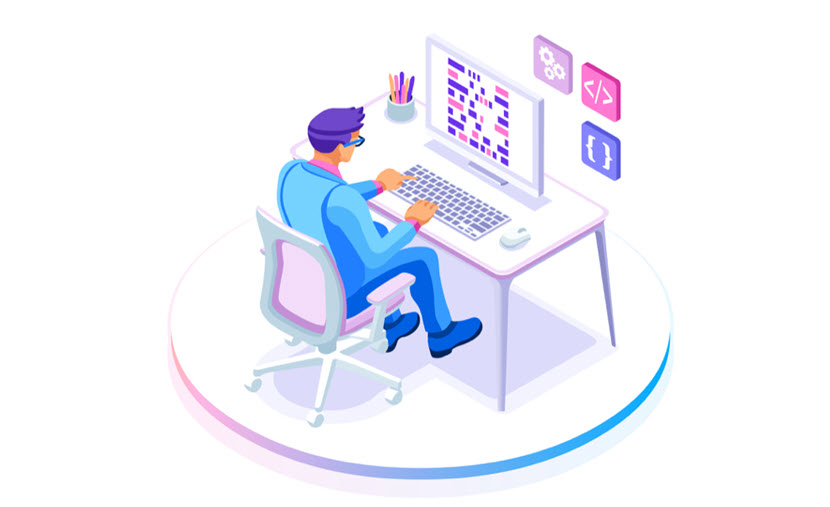
What Programming Language Is the Best for AI?
Python is widely considered the best programming language for AI. Developers love using Python due to its simplicity, readability, and the extensive number of available frameworks. Strong community support is also a considerable factor in Python's popularity.
Which Language Is Better for AI, Java or Python?
Python is generally preferred over Java for AI development because of its concise syntax, ease of use, and the vast number of specialized AI libraries. However, Java is the preferred choice for business AI development, where robustness and scalability are critical.
Is AI Written in Python?
Yes, a significant portion of AI development is written in Python. Python's extensive ecosystem makes this language ideal for various AI tasks, from machine learning to natural language processing.
Is C++ Good for AI?
C++ can be suitable for AI in some scenarios. Many AI developers use C++ when performance and memory management are vital to the project. C++ is also a common choice when AI applications require high efficiency (e.g., game development or real-time systems). However, due to its complexity, C++ is considerably less popular than Python for AI development.
Pick a Language and Start Cracking the Books
The World Economic Forum projects that the AI sector will employ 97 million people by 2025. Having the right skills can make all the difference in this rapidly growing industry.
To stand out, ensure you have proficiency in at least a few of the AI programming languages discussed in this article. That way, you will be ready to contribute at a high level once you land an AI development job.
